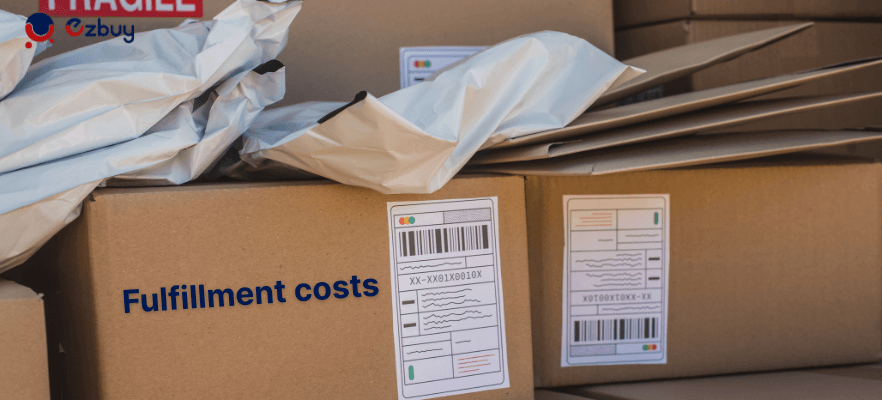E-commerce Fulfillment to Japan: A Complete Guide for Global Sellers
By Macy -21/05/2025 UTC.
Expanding your e-commerce business to Japan has the power to transform your business. With one of the technologically advanced populations of the globe and one of the most impressive logistics networks in the world, Japan offers tremendous potential to international sellers.
However, to take root in the market, you will not just require an amazing product - you will require e-commerce fulfillment beyond just logistics, tailored to Japanese customer needs. In this article, we will discuss all you will need to know about e-commerce fulfillment to Japan, from logistics models to affordable tactics.
1. Why Japan is a Crucial Market for E-commerce Fulfillment
Japan is the globe's fourth-biggest e-commerce market, and Japan e-commerce logistics revenue will likely reach USD 200 billion in 2025. Japanese consumers have very high expectations of packaging, product quality, and delivery speed. That makes fulfillment very critical for your customer experience.
Further, Japan's urban population, advanced payment infrastructures, and high rates of internet coverage have created perfect opportunities for cross-border e-commerce in Japan. If you want to penetrate a high-value market with high purchasing power and great demand for imported goods, Japan must top your target market priority.
2. Key Components of E-commerce Fulfillment to Japan
E-commerce fulfillment to Japan is very meticulous and structured. Shoppers in Japan are famous for expecting rapid delivery, efficient communication, and courteous service. Overseas merchants have to take care of every detail of the fulfillment process, from warehousing to last-mile delivery, to ensure all this.
Inventory management
Inventory requires sellers to have stock in some form of warehouse to process packages at the time of purchase by customers. Maintain your current levels and replace your stock quickly to satisfy demand from customers and delivery expectations.
Order handling
Order fulfillment needs to be both speedy and error-free. Automating the synchronization of orders with your inventory system can minimize the human error factor, save time, and keep the customers updated in real time. With the Japanese market being as detail-oriented as it is, even small errors in shipping labels or product picking will have adverse impacts on the customer experience.
Packaging
Japanese packaging standards are some of the highest in the world. Clean, well-organized, and protective packaging is not only expected - it's a mark of professionalism on the part of the brand. Environmentally friendly packaging solutions are also greatly prized by many consumers, so recycling materials can make your brand more attractive in this market.
Delivery and shipping
Domestic courier companies like Yamato Transport and Sagawa Express have attained a high level of punctuality and service. This requires fulfillment providers or carriers that understand the complexity of Japan's logistics networks and the behavior of consumers.
Returns management
Although Japanese return rates are lower than in the West, a simple and transparent return policy generates confidence and repeat purchasing. Good reverse logistics, clearly documented return procedures, and world-class customer service will all impress Japanese consumers.
3. Japan E-commerce Logistics: What Makes It Different?
Japan e-commerce logistics infrastructure for e-commerce is one of the most advanced and efficient in the world, but it also involves certain expectations and operating standards that are a long way from Western markets.

High delivery standards
One of the most defining features of Japan's logistics profile is its extremely high delivery expectations. Same-day or next-day delivery is not a nicety; it's an expectation. Deliverers like Yamato Transport (Kuroneko) and Sagawa Express have a reputation for punctuality and precision.
Missed deliveries are also handled differently. In Japan, customers choose specific time-of-day delivery, and in case a delivery fails, there is convenient rescheduling by phone or online systems with little resistance.
High customer service expectations
Customer service standards also have a significant effect on the operations of logistics. Couriers ought to be respectful, courteous, and even quiet during delivery, especially in residential areas. It is not rare for them to bow while delivering parcels, and damaged or delayed shipments can easily ruin a brand's reputation.
Dense urban infrastructure
Close-packed Japanese urban infrastructure is advantageous and disadvantageous at the same time. While the dense population and properly developed public transportation guarantee quicker last-mile delivery inside cities, compact streets and complicated address systems could turn out to be challenging for non-local couriers. For this reason, it is needed to cooperate with fulfillment partners with deep local experience.
Convenience store networks
Another unique aspect is the importance of convenience store networks. Japan has over 50,000 convenience stores, some of which serve as package pickup and delivery points. This provides customers with a convenient means of receiving or returning products, especially for those who may not be at home when delivery occurs. Including this option in your fulfillment strategy can greatly improve customer satisfaction.
>>> Read more: Ecommerce Logistics in Japan - Navigating Fulfillment and Cross-Border Shipping Solutions
4. Japan E-commerce Fulfillment Models
Choosing the right Japan e-commerce fulfillment model is an important strategic decision when entering the Japanese e-commerce market. Japan offers a range of fulfillment options, each with advantages depending on your business size, product category, and delivery requirements.
4.1. Cross-border fulfillment
In this scenario, suppliers drop-ship from their home country and ship directly to Japanese consumers. It is the most straightforward way to try out the market with no investment in local infrastructure. However, it is linked with higher delivery lead times (about 5-10 business days), higher shipping costs, and higher risks of delivery delays via customs clearance. Good enough for many special or niche products, the model falls short of the speed of most Japanese consumers' expectations.
4.2. Third-party logistics (3PL) fulfillment within Japan
Cooperation with a Japanese domestic 3PL provider allows the sellers to hold inventory in Japan and have it shipped domestically. It conserves significant transit times (which can be same-day or one-day), has lower foreign shipping expenses, and has stricter regulation compliance, such as right labeling and appropriate packaging regulations.
An ideal 3PL company can even offer returns handling, Japanese customer service, and integration with the big marketplaces like Rakuten, Amazon Japan, and Yahoo! Shopping.
4.3. Marketplace fulfillment
Fulfillment by Amazon (FBA) Japan or similar marketplace-specific services offer end-to-end fulfillment, e.g., storage, picking, packing, and shipping. Such programs are heavily integrated with the platforms they are on, making it easier to qualify for benefits like Prime eligibility and search results visibility.
However, sellers are required to conform to strict packaging and inventory controls, and it may be costly. Marketplace fulfillment also gives customers and brands less control than utilizing your own 3PL.
4.4. Hybrid fulfillment model
Some businesses combine multiple approaches. For instance, they may use cross-border shipping for slow-moving SKUs, while storing best-selling items with a 3PL in Japan. This hybrid strategy allows for flexibility and cost optimization, particularly when managing seasonal demand or limited storage budgets.
5. How to Choose the Right Fulfillment Partner for Japan
Choosing the right fulfillment partner is one of the most significant decisions when you are taking your e-commerce business to Japan. A good logistics partner can help you make promises come true, save money, stay compliant, and build a good brand reputation in a highly competitive market.
Local expertise and infrastructure
Japan's logistics landscape is very sophisticated but also unique when it comes to delivery standards, customer service levels, and address systems. Look for fulfillment providers with physical presence in Japan, ideally with warehouses strategically located close to the country's key metropolitan areas like Tokyo, Osaka, or Nagoya. Local knowledge ensures smoother last-mile delivery and fewer operational disruptions.
Speed and delivery options
Japanese consumers have been accustomed to quick and easy delivery, very probably in a single or two days. Your partner needs to be capable of offering multiple shipping speeds, time-slot pickups, and even same-day options where needed. Bonus points if your partner integrates into Japan's convenience store pick-up networks that local consumers adopt fully.
Technology integration
Your fulfillment partner should be able to sync smoothly with your e-commerce marketplaces and platforms such as Shopify, Amazon Japan, Rakuten, or Yahoo! Shopping. Real-time syncing of inventories, automated processing of orders, and tracking updates are operational efficiencies and transparency necessities.
Transparent pricing and scalability
Cost transparency is key - watch out for hidden fees related to storage, pick-and-pack, or last-mile delivery. Choose a partner that can grow with your business, whether you’re handling 100 orders a month or scaling to thousands. Ask about volume discounts, seasonal storage options, and capacity for peak seasons like New Year or Golden Week.
6. Fulfillment Costs and Profitability Tips
It can be highly lucrative to enter Japan, but controlling e-commerce fulfillment to Japan is key to achieving good margins. Japan's logistics services are of high quality, and typically high-cost. In order to succeed, you need to understand where your money is going and how to maximize each cost segment without compromising service.

6.1. Break down the fulfillment cost structure
Understanding the typical components of fulfillment fees in Japan helps you forecast accurately. These usually include:
- International shipping: The cost to send products from your country to Japan.
- Storage fees: Monthly charges based on the amount of space your inventory occupies.
- Pick and pack fees: Costs for selecting, packing, and labeling each order.
- Last-mile delivery: Domestic delivery within Japan, often dependent on package size and speed.
- Returns processing: Fees for handling returned goods and restocking (if any).
Some fulfillment partners also charge setup fees, system integration fees, or minimum monthly usage charges. Therefore, always request a detailed cost breakdown and watch for hidden fees.
6.2. Optimize storage and inventory turnover
Storage capacity in Japan is limited and sometimes expensive. Avoid overstocking by using data-driven forecasted inventory. High-moving products need to stay in Japan-based warehouses for rapid turnaround, while low-moving products can be shipped cross-border or warehoused in bulk outside Japan. Flexible or seasonal storage space can be arranged with some 3PLs - ideal for managing sales spikes.
6.3. Consolidate shipments and use local sourcing (When possible)
Shipping from abroad, bundling items into fewer, heavier shipments (instead of standard lighter ones) will lower per-unit incoming shipping costs and decrease customs fees. If possible, source or assemble locally to avoid international shipping entirely and become a domestic seller.
6.4. Leverage automation and integrations
Automated systems reduce labor and order mistakes. Automate processes like order syncing, tracking updates, and inventory alerts by syncing your e-commerce website with your fulfillment partner. Not only does it reduce fulfillment time, but it also saves you money on customer support and returns by avoiding human error.
7. Challenges in E-commerce Fulfillment to Japan & How to Overcome Them
While Japan presents tremendous room for growth for e-commerce, it also presents an exceptionally diverse range of fulfillment challenges to overcome. They will need to be adequately prepared to overcome them, from cultural customs to cultural differences and issues with regulation. Some of the most common challenges - and effective solutions - are outlined below.
Complex addressing and delivery logistics
Japanese addresses have a unique format that makes them confusing for foreign deliverers. The narrow streets and hard-to-find buildings within the densely populated city center may cause failure in delivery.
Use local delivery carriers like Yamato Transport or Sagawa Express, which know the geography locally and the local customer expectations. Your fulfillment system should allow for correct address formatting and validate the customer details at the checkout.
Strict packaging and presentation requirements
Packaging is not only functional within Japan but is an integral part of the product experience. Over-packaging, dented, or clumsy packaging could create complaints from customers or even returns.
Invest in proper, clean, and good packaging for your product. Partner with fulfillment centers that provide packaging customization and kitting to cater to Japanese needs. Invest in the usage of eco-friendly materials, as Japanese customers place great importance on sustainability.
Regulatory and customs barriers
Imports from Japan are closely regulated with specific import controls on items ranging from food, supplements, and cosmetics to electronics. Misdescription, or even inaccurate or missing documents, may cause customs delay, fines, or refused shipments.
Deal with fulfillment centers or customs brokers with experience in the Japanese market. Recheck that documentation is accurate and compliant, and that items comply with labeling, safety, and language regulations. If unsure, seek assistance from Japan's official customs and trade regulations or engage local regulation consultants.
Returns and reverse logistics
Although return rates are low overall in Japan, customers desire an easy, simple process when there is a return. Returns done poorly harm brand reputation.
Establish an easy, well-documented returns policy that will meet local customer expectations. Partner with a fulfillment company that includes return processing in Japan, including pickup or drop-off at convenience stores. Honesty and speedy resolution help ensure customers remain content.
>>> Read more: Logistics Companies in Japan – Your Guide to Top Providers in 2025
8. Contact Ezbuy Japan for E-commerce Fulfillment
Selling to Japan's e-commerce market can be both profitable and complex, but you do not need to do it by yourself. Ezbuy Japan is your preferred fulfillment partner, making logistics, compliance, and customer expectations simple for international sellers.

With deep local expertise and a dedicated fulfillment network across Japan, Ezbuy Japan delivers a one-stop e-commerce fulfillment to Japan solution. We provide:
- Domestic warehousing in Japan for fast, reliable shipping
- Integration with major marketplaces like Amazon Japan, Rakuten, and Yahoo! Shopping
- Custom packaging, returns management, and compliance assistance
- Transparent pricing with no hidden fees and solutions sized to every business scale
Our team understands what it takes to shine in Japan's high-performance market. We go beyond logistics - we help you to deliver an experience that will delight Japanese consumers and build your brand.
Ready to start or streamline your fulfillment in Japan? Contact us today to schedule a consultation or request a custom quote. Let Ezbuy Japan be your local partner for global growth.
Email: [email protected]
Website: https://ezbuy.jp/en
9. Conclusion
As one of the globe's most advanced and demanding e-commerce markets, Japan offers amazing opportunities for global sellers, but your success will ride on your ability to deliver to satisfaction. With shipping demands so high, cultural sensitivities to observe, regulatory compliance to meet, and last-mile issues to overcome, no aspect can be left behind. By taking the right strategy and fulfillment decision, you can design a seamless, streamlined operation that meets local regulations and delights Japanese consumers.
Whether you're building a brand or are an established trader, E-commerce fulfillment to Japan isn't logistics - it's an opening to extended expansion in high-value market space. Proper implementation enables you to use operational complexity as a differentiator and build a responsible profile in one of Asia's wealthiest e-commerce forums.